Principality of Hashima
This article refers to a micronation or element of micronationalism which is defunct and no longer exists. You can help make the article reflect that or ask on the talk page for further information. |
Hashimai Hercegség (HU) Principato di Hashima (IT) Principality of Hashima (EN) | |
|---|---|
Flag
Coat of arms
| |
| Motto: "Együtt dolgozunk egy jobb jövő érdekében" (HU) "Lavoriamo insieme per un futuro migliore" (IT) "Work together for a better future" (EN) | |
| Anthem: "Hashimai Királyi Himnusz" (HU) "Inno Reale di Hashima" (IT) "Royal Anthem of Hashima" (EN) | |
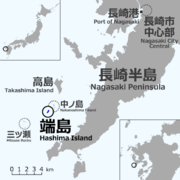 | |
| Capital and largest city | Hashima |
| Official languages | Hungarian, Italian |
| Demonym(s) | of Hashima |
| Government | Absolute Monarchy, Diarchy |
| Prince Fabrizio I of Hashima, Princess Enikő I of Hashima | |
| Crown Prince Umberto of Hashima | |
| Legislature | Parliament of Hashima |
| Establishment | 28 September 2014 |
| Population | |
• (Registered online) census | 137 |
| Currency | Lirint of Hashima |
| Time zone | UTC+8 |
Hashima, officially the Principality of Hashima (Hashimai Hercegség HU, Principato di Hashima IT), was a autonomous territorial entity based in Hashima (an Asian island), which claimed to be a sovereign state, but was more commonly referred to as a micronation by external observers.
The Principality of Hashima was the founding member of the United Micronations, co-founding member (together with the Decracy of Vilthia) of the Saint Matthew Economic Pact and also a member of the Union Against Micronational War.
Etymology
The name Hashima (Japanese: 端島) literally means "Ha Island".
"Battleship Island" is an English translation of the Japanese nickname for Hashima, "Gunkanjima" ("Gunkan" means battleship, "Jima" being the Rendaku form of Shima, means island). The island's nickname comes from its apparent resemblance to the Japanese battleship Tosa.
History
During Mitsubishi-Japan control
The island was populated from 1887 to 1974 as a coal mining facility. Its most notable features are the abandoned and still mostly intact concrete apartment buildings and the surrounding sea wall. The island has been administered as part of Nagasaki city since the merger with the former town of Takashima in 2005.
It is known for its coal mines and their operation during the industrialization of Japan. Mitsubishi bought the island in 1890 and began extracting coal from undersea mines. In 1916, the company built Japan's first large concrete building (9 floors tall), a block of apartments to accommodate their burgeoning ranks of workers. Concrete was specifically used to protect against typhoon destruction.
Starting from the beginning of the 1930s, until the end of the Second World War, Korean conscripted civilians and Chinese prisoners-of-war were forced to work under very harsh conditions and brutal treatment at the Mitsubishi facility as slave laborers under Japanese wartime mobilization policies.
In 1959, the 6.3-hectare (16-acre) island's population reached its peak of 5,259, with a population density of 835 people per hectare (83,500 people/km², 216,264 people/m²) for the whole island, or 1,391 per hectare (139,100 people/km²) for the residential district.
As petroleum replaced coal in Japan in the 1960s, coal mines began shutting down across the country, and Hashima's mines were no exception. Mitsubishi officially announced the closing of the mine in 1974, and today the buildings are empty and the island is unpopulated.
As People's Republic of Hashima

During the first year of independence, the People's Republic of Hashima opened mutual recognition and diplomatic affairs with several Micronations, including (but not only) with the Empire of Choseon and the Kingdom of Ruthenia.
The People's Republic of Hashima founded the Asian Micronations (known until 2 March 2015 as Organization of Asian Micronations, closed in 19 October 2015) and the United Micronations.
The President Feng Li of Hashima drawn a project of redevelopment of the Island of Hashima (planned for a far future) and has been in a diplomatic trip around the Italian peninsula (Italy, San Marino and Vatican City) and also in Malta. During his absence, the presidency has been temporarily assumed by the Vice-President Zhu He (as acting President). This has been the first time for the People's Republic of Hashima that the Presidency has been changed (just temporarily).
In 22 October 2014, the Parliament of the People's Republic of Hashima passed a restricting law for the immigration, for counteract the risk of Ebola.
For four days (from 19 to 22 February 2015) the President Feng Li of Hashima has been hospitalized for a severe back pain.
Since the coming of 2015, the People's Republic of Hashima did big steps forward for improve itself and being more complete and competitive inside the politic world. In March, the People's Republic of Hashima joined the Union Against Micronational War, giving a strong message to the world that Hashima doesn't tolerates wars, and since the end of August started to open foreign embassies (only de facto) in various world Countries where actually lives the population (the first has been opened in Budapest, Hungary, in 29 August 2015).
In 19 June 2015, several Ministers resigned for personal reasons, and the same day the population voted the new Ministers that have been appointed officially by the President Feng Li the day after, in 20 June 2015.
In 28 September 2015, for the celebrations of the first anniversary of Independence, every foreign embassy hosted a party with the local portion of the population of Hashima. The biggest party has been in Budapest, with the presence of the whole Parliament, the President Feng Li of Hashima and also of the Empress of the Great Empire of Dikameppra, Ekaterina Xözet Lebedeev I.
Achieved the first year of independence, in 5 October 2015 the Govern of the People's Republic of Hashima proposed to the President Feng Li two referendums: the first one for ask to the population about their level of happiness under the past year of independence; the second one for ask to the population about the decision to keep or change the national flags and coat of arms, including a series of alternatives if the wish of the citizen was to change.
The President Feng Li approved both of them, choosing 7 October 2015 as day for their implementation.
In 8 October 2015, results of the two referendums have been revealed; the first referendum (with 103 positive votes and 7 negative votes) showed an high level of happiness of the population, and the second (with 49 "keep" votes and 61 "change" votes) showed the wish of the population to change the national flags and coat of arm.
Following the decision of the second referendum, the Govern immediately approved a law for the change of the national flags and of the coat of arms.
The new flags and coat of arms have been chosen unanimously by who voted for change, between a large number of alternatives.
The citizens that voted for the change have highlighted that especially the previous national flag was too much similar to the Chinese flag, and the new one is more unique and easily recognizable between the other world flags.
The People's Republic of Hashima continued to open foreign embassies (only de facto) with the increasing of the population coming from other Countries.
In 13 October 2015, after a formal request received from the Popular Union of Occitania, the People's Republic of Hashima authorized them to use the Yuan of Hashima as their official currency.
In 15 October 2015, after also a suggestion coming from the Kingdom of Blackland, the Govern announced a referendum to be took in 19 October 2015, where the population will be invited to decide about the recognition of Israel and about Palestine, choosing to recognize one of them, both, or nobody.
In 20 October 2015, results of the referendum have been revealed (with 100 votes for the recognition of both, and just 11 votes for the recognition of only Palestine), showing the wish of the population to recognize only the Arab Country.
Following the decision of the referendum, the Govern immediately confirmed the recognition of Palestine as a sovereign state and implemented the recognition of Israel too.
In 25 October 2015, the President Feng Li of Hashima announced that the whole Govern and himself decided to work on a big revision of Hashima, including the possibility to change the national language (with Hungarian and Italian), the kind of government and the name of the Country.
As Principality of Hashima

In 26 October 2015, the change of denomination and national languages have been formalized.
In 29 October 2015, other 7 foreign embassies have been opened around the world, the first time since the change of denomination of Hashima.
In the same day, the Govern approved a law for the change of national flags and coat of arms, due to the new national languages and kind of government.
The new flags (national and navy flag) and coat of arms have been unveiled the day after, in 30 October 2015.
The change of denomination required also further other changes, like a new official website, new official main email address, renomination of the official account on Twitter and of the national currency, that has been renominated into Lirint of Hashima.
All the diplomatic affairs achieved during the "People's Republic of Hashima" denomination has been kept, as how the membership inside the United Micronations, and the members of the Parliament have been confirmed by the Prince and the Princess.
The first foreign treaty signed with another Micronation, after the change of denomination of Hashima, has been with the Republic of New England, on 30 October 2015, after had contacts between their official Twitter accounts.
Prince Fabrizio the first and Enikő the first, was until 31 December 2015 monarchs of the Principality of Hashima, when they abdicated and the Principality subsequentially dismissed.
Geography

Of volcanic origin, the island is 18 kilometers from Nagasaki and is one of the 505 deserted islands of the prefecture of the same name. Located in the south of the coast of Japan, in the East China Sea, is about 480 meters long and just under 150 in width to a width of only 0,063 square kilometers.
Originally, the island had an area much smaller and featured a small mountainous in the center. Since 1896 its territory was gradually expanded into six phases close that led to assume its present shape in 1931, and the relief was partially cleared to be able to build the buildings still present.
The whole area of the island is so heavily urbanized north-east is concentrated what once was the residential area, with several multi-storey buildings that were used as houses and complementary services, while in the south-west there was the great industrial area of the mining establishment, which branched off into several tunnels just below the seabed. The deepest underground tunnel stretched for more than 1 km in depth; it is estimated that about 200 miners lost their lives working on the site.
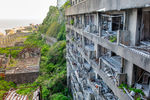
In 1959, the period of maximum density of population, the island grew to 60,000m² of residential building, a hospital, a school, temples, about 25 shops, bars, a cinema, a gym, a baseball field and a brothel. Among the residential buildings there is also the first reinforced concrete building built in Japan, dating back to 1916; it still remains of housings representative period running from Taisho period to the Showa.
However live to Hashima presented many problems of adaptation. The houses, owned by Mitsubishi, were assigned according to a strict protocol of social hierarchies: the miners bachelors were housed in apartments, those with families in apartments with bathroom and kitchen with other tenants; administrative staff, nurses and teachers in two-room apartments with kitchen and bathroom included. Only executives were entitled to larger homes and independent.
Despite being equipped with all necessary services, Hashima represented a somewhat alienating reality where the supply of goods, food, drinking water was guaranteed solely by supplies from the mainland that were often severely hampered by violent typhoons that raged around the island for about 160 days a year, making it impossible to navigation and mooring of vessels to small wharf. For this reason, to protect the entire island was built the high and thick walls, still visible along its entire perimeter.
After almost forty years of prolonged neglect, salt and weather have favored the irreversible process of structural decay and the island looks desolate, with the looming presence of its many buildings in ruins. Many of them are now partially collapsed, crumbling, infested with wild vegetation, or so dilapidated as to make prohibitive a full tour along the streets, almost everywhere littered with rubble.
Weather
The climate of the island, now as then, is characterized by strong winds and stormy cyclical phenomena; also the arid soil did not allow the cultivation and therefore there was never the possibility and the space for green areas and public gardens. In this regard, some former residents organized themselves bringing the island's fertile soil for groped to create vegetable gardens on the flat roof of the houses but with little success. Very significant is the testimony of Hideo Kaji, a former inhabitant was born and raised on the island interviewed by CNN in 2013, revealed that:
"[...] Hashima was a place free of bushes, flowers and children growing up without knowing what they were cherry trees in bloom. Even the seasons were perceived differently, could be distinguished from each other only by how the wind was blowing or the color of the sea. "
Below there is a box with information about average normal temperatures and precipitations in Hashima.
| Climate data for Hashima | |||||||||||||
|---|---|---|---|---|---|---|---|---|---|---|---|---|---|
| Month | Jan | Feb | Mar | Apr | May | Jun | Jul | Aug | Sep | Oct | Nov | Dec | Year |
| Average high °C (°F) | 9.9 (49.8) |
10.6 (51.1) |
14.1 (57.4) |
19.4 (66.9) |
23.1 (73.6) |
25.8 (78.4) |
29.7 (85.5) |
31.3 (88.3) |
28.1 (82.6) |
23.3 (73.9) |
17.9 (64.2) |
12.5 (54.5) |
20.5 (68.9) |
| Daily mean °C (°F) | 6.4 (43.5) |
7.0 (44.6) |
10.1 (50.2) |
15.2 (59.4) |
19.0 (66.2) |
22.3 (72.1) |
26.6 (79.9) |
27.6 (81.7) |
24.3 (75.7) |
19.0 (66.2) |
13.7 (56.7) |
8.8 (47.8) |
16.7 (62.1) |
| Average low °C (°F) | 3.1 (37.6) |
3.7 (38.7) |
6.3 (43.3) |
11.3 (52.3) |
15.4 (59.7) |
19.3 (66.7) |
24.0 (75.2) |
24.7 (76.5) |
21.1 (70) |
15.3 (59.5) |
10.1 (50.2) |
5.3 (41.5) |
13.3 (55.9) |
| Average Precipitation mm (inches) | 10 (0.39) |
9 (0.35) |
10 (0.39) |
11 (0.43) |
10 (0.39) |
12 (0.47) |
11 (0.43) |
8 (0.31) |
9 (0.35) |
6 (0.24) |
8 (0.31) |
9 (0.35) |
113 (4.45) |
| Source: yr.no | |||||||||||||
Transports
In the Principality of Hashima, there aren't highways, railways and airports, because the island's little size (480x150 meters).
According to the Constitution of the Principality of Hashima, citizens aren't allowed to possess (and/or drive) every kind of vehicle with an engine that works with fuel (like cars, motorcycles, ecc...).
There is only a street, that connects the whole island, doing a lap of the island.
For can arrive into the island, is possible to take a ferry boat from the Japanese city of Nagasaki.
There aren't airports in Hashima, the nearest one is in the Japanese city of Nagasaki.
The Principality of Hashima has a pier that allows to people and goods to enter inside the national territory.
Economy
The economy of the Principality of Hashima is managed by the Ministry of Finance and Economic Development.
The Ministry of Economy is also responsible for the emission of national currency, called "Lira of Hashima".
In the Principality of Hashima, according to the Constitution, all kind of salaries can't exceed 1000 Yuan of Hashima per month.
The national post service, property of the government (state-owned enterprise), is the Hashima Post.
Inside the Principality of Hashima territory there's only a bank, called "Bank of Hashima", that is a public bank, govern-owned company. Its main task is dispensing salaries from the govern to the citizens, and banking services.
However, both of them (Bank of Hashima and Hashima Post) still can't operate inside the national territory, and they are active only de jure.
Politic
Within the Principality of Hashima, the Parliament of Hashima represents the government of the Republic.
It has only a branch, called Senate (Szenátus HU, Senato IT), and it's formed by 11 members (10 ministers, plus the Prime Minister).
People can vote for elections of the members of the Senate; the minimum age for can vote is 18 years old.
Citizens that are members of the Nationalist Party of Hashima can also being candidate for be a new minister; the minimum age for can be a candidate is 25 years old.
The Prime Minister is chosen by a member of the Royal Family and has the title of Crown Prince.
The Supreme Court of Hashima is the highest judicial authority in the Principality of Hashima.
The Prince of Hashima and the Princess of Hashima are together leader of the Nationalist Party of Hashima.
Political Parties
Within the Principality of Hashima, there is only one political party, the Nationalist Party of Hashima.
| Party Name | Emblem | Short Name | Leader(s) | Position | Colours | Seats in Parliament |
|---|---|---|---|---|---|---|
| Hashimai Nacionalista Fél (HU) Partito Nazionalista di Hashima (IT) Nationalist Party of Hashima (EN) |
 |
HNF (HU) PNH (IT) |
Prince Fabrizio I of Hashima Princess Enikő I of Hashima |
Nationalist | Red and white | 11 / 11
|
Senate - Ministers
In 19 June 2015, several Ministers resigned for personal reasons, and the same day the population voted the new Ministers that have been appointed officially the day after, in 20 June 2015.
In 26 October 2015, following the change of denomination of Hashima, the Minister of Home Affairs of Hashima resigned for health problems, and a new one has been appointed by the Prince of Hashima.
Below is possible to find the links for the articles of the Ministers of the People's Republic of Hashima.
- Deputy Prime Minister of Hashima
- Minister of Defence
- Minister of Education, University and Research of Hashima
- Minister of Employment and Citizenship of Hashima
- Minister of Environment, Protection of the Territory, of the sea and of the Agriculture of Hashima
- Minister of Finance and Economic Development of Hashima
- Minister of Foreign Affairs of Hashima
- Minister of Health and Welfare of Hashima
- Minister of Heritage, Cultural Activities and Tourism of Hashima
- Minister of Home Affairs of Hashima
- Minister of Justice of Hashima
- Prime Minister of Hashima
Languages
Inside the Principality of Hashima, Hungarian and Italian have together the status of national languages.
English is the most known foreign language, used especially along the national language in foreign relationships, but it doesn't have status of official language.
Being a multicultural population, coming from various Countries of the world, the population of the People's Republic of Hashima has also other unofficial languages spoken in their native Countries, like Chinese for who comes from China, or Ukrainian for who comes from Ukraine.
Citizenship

According to the Constitution of the Principality of Hashima, the citizenship is granted to:
- A son/daughter of a father/mother with citizenship of the Principality of Hashima, who was born inside the national territory;
- A son/daughter of a father/mother with citizenship of the Principality of Hashima, who was born outside the national territory;
- Everyone that has received it by an Act of Parliament or a Royal Decree;
- Everyone that has applied for the citizenship from the official website, and has received a positive answer.
In the Principality of Hashima, the citizenship is assigned to people by the Citizenship Department in the various foreign embassies of the Principality of Hashima.
It provides citizens of a passport (in "png" image file), that citizens can print and use as personal document, only inside the national territory and the foreign embassies.
For can apply for the citizenship of the Principality of Hashima is necessary to send an email at the Citizenship Department (theprincipalityofhashima@gmail.com , the main email address of the Principality of Hashima), and the local foreign embassy will take in care the request.
Population

The Principality of Hashima has an overall population of 137 persons (November 2015 census).
135 are the people that have a normal citizenship, two instead received an honorary citizenship (Titianus II and Alessia Garazzini), both of them members of the Decracy of Vilthia, as prizes for their achievements during diplomacy with Hashima.
These persons don't live inside the national territory, but have applied for the citizenship and received it (registered online).
Usually, the Citizenship Department contacts random people around the world on internet, offering the opportunity to can apply for the Citizenship, if they match the requirements for can receive it.
People that get the citizenship can also apply (or the Govern can also ask/require) for the establishment of a new Embassy in their native Country, if they match the following requirements:
- To join the Citizenship Department and take care of the citizenship requests from people located in the Country of their Embassy;
- To take care of the duties of the Embassy;
- To respect the laws of the Principality of Hashima;
- To exhibit the national flag of the Principality of Hashima inside and/or outside the Embassy.
Actually, the population of the Principality of Hashima is a mix of people that originally born in various Countries of the world. The objective of the Principality of Hashima is to can have a multicultural and multi ethnic population, with every freedom and right granted.
Administrative divisions
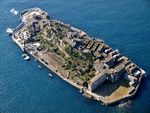

The Principality of Hashima, due to its little surface, is administrated under an only division, comprising an only one city and none regions or provinces.
The city of Hashima has a local flag, consisting of six horizontal stripes of equal proportions (pink, white, blue, gold, green and red).
The mayor of the city of Hashima is chosen by the population after a vote.
People can vote for elections of the new mayor; the minimum age for can vote is 18 years old.
Citizens that are members of the Nationalist Party of Hashima can also being candidate for be the new mayor; the minimum age for can be a candidate is 25 years old.
| Flag | Postal code | City | Claimed area | Registered population | Mayor |
|---|---|---|---|---|---|
| HSM | Hashima | ~0,063 km² | 111 | Xiang Nang |
National Corps
The Principality of Hashima has 6 national corps (active only de jure).
According to Article 2 of its Constitution, the Principality of Hashima rejects war as an instrument of aggression against the freedom of other peoples and as a means of settling international disputes; Hashima promotes and encourages international organizations addressed to peace and justice between world nations.
The Principality of Hashima, according to its Constitution, can declare war to another Nation only for defensive purposes.
| Logo | Name | Leader | Notes |
|---|---|---|---|
| Air Force of Hashima | Prince Fabrizio I of Hashima | Active only de jure | |
| Army of Hashima | Prince Fabrizio I of Hashima | Active only de jure | |
| Customs and Border Protection of Hashima | Prince Fabrizio I of Hashima | Active only de jure | |
| Fire and Emergency Service of Hashima | Prince Fabrizio I of Hashima | Active only de jure | |
| Navy of Hashima | Prince Fabrizio I of Hashima | Active only de jure | |
| Police of Hashima | Prince Fabrizio I of Hashima | Active only de jure |
National Currency
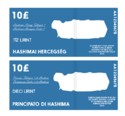
Within the Principality of Hashima, the national currency is the Lirint of Hashima, valid only inside the national borders and foreign embassies of the Principality of Hashima. Every use outside these places is strictly forbidden.[1]
Before the change of denomination of the Micronation, the currency was called "Yuan of Hashima".
The Principality of Hashima planned for the Lirint of Hashima some commemorative banknotes for the future, but not further info have been published.
It has only banknotes in Lira (₤) values, for 1, 5, 10, 50 and 100 Lirint.[2]
The banknotes have same length and height between them. Each note have the facial value expressed in numbers, symbols and letters, with also a serial number, the map of the Principality of Hashima (on both the sides) and signatures of Prince and Princess of Hashima.
The Lirint of Hashima is also used for the postal service (stamps) inside the Principality of Hashima and its foreign embassies.
Stamps (as how the banknotes) are printed by the Government of the Principality of Hashima, in values of 10 Centiller, 50 Centiller, 1 Lirint and 5 Lirint.
The design of the stamps remains the same every year, until the arrival of a new series (this actual series is planned to be used for several years).
From 13 October 2015 until 12 November 2015, has been used also by the Popular Union of Occitania. In 12 November 2015, after the end of relations between Occitania and Hashima, the permission to can use the Lirint of Hashima has been denied to Occitania and every further use of the Lirint of Hashima from the Popular Union of Occitania is strictly forbidden.
Culture and Sport
Media

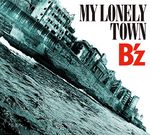
The 1949 Japanese film Midori Naki Shima (The Greenless Island) was shot on Hashima Island.
The Japanese rock band B'z used the island as the location for the filming of the music video for their 2009 single "My Lonely Town" and also shot photos for the CD cover and packaging there.
The island featured in a 2009 episode of History Channel's Life After People.
In the 2012 James Bond movie Skyfall, the island served as an inspiration for the lair of villain Raoul Silva. Although exterior footage of the island is featured, no scenes were filmed on the island itself. Exterior sets of the island were recreated using a combination of CGI and practical effects at Pinewood Studios in Great Britain.
The 2013 Thai horror movie Project Hashima depicts five college students who visit Hashima Island for filming.
The island is also one of the settings for a series of upcoming live-action Japanese films based on the manga Attack on Titan.
On 19 December 2014, the island was featured in Japanese-American music artist Nano's song "Rock on" for the entire music video.
Museums
The Numismatic collection of Prince Fabrizio I of Hashima, also simply known as Numismatic Collection, is the national and unique collection (kinda of museum) of the Principality of Hashima. It is property of the Prince Fabrizio I of Hashima, and it is located in Messina (Italy), his birthplace.
National Days
This is the list of the national days inside the Principality of Hashima:
| Date | Name | Type | Notes |
|---|---|---|---|
| 1 January | New Year's Day | Public holiday (national) | The start of the new year. |
| The third Sunday in January | World Religion Day | Day of commemoration | Interfaith commemoration day. |
| 14 February | Valentine's Day | Day of commemoration | Celebration of the love. |
| 21 February | International Mother Language Day | Day of commemoration | Promote awareness of linguistic and cultural diversity and multilingualism. |
| The third Monday in February | Family's Day | Day of commemoration | Celebration of the family. |
| 21 March | International Day for the Elimination of Racial Discrimination | Day of commemoration | Demonstrate support for environmental protection. |
| 22 April | Earth Day | Day of commemoration | Demonstrate support for eliminate all forms of racial discrimination. |
| 1 May | International Workers' Day | Public holiday (national) | Celebration of laborers and the working classes. |
| 19 May | Prince's birthday | Public holiday (national) | Celebration of the birthday of Prince Fabrizio I of Hashima. |
| The third Sunday in June | Father's Day | Day of commemoration | Celebration of the fathers. |
| The third Sunday in July | Mother's Day | Day of commemoration | Celebration of the mothers. |
| 8 August | Wars Victims Day | Day of commemoration | Celebration of all the persons died in every war. |
| 28 September | Independence Day | Public holiday (national) | Celebration of the Declaration of Independence on 28 September 2014. |
| 2 October | International Day of Non-Violence | Day of commemoration | International day of Non-Violence. |
| 4 October | World Animal Day | Day of commemoration | International day of action for animal rights and welfare. |
| 26 October | Monarchy Day | Public holiday (national) | Celebration of the establishment of Monarchy on 28 September 2014. |
| 30 October | National Flag and Coat of Arms Day | Public holiday (national) | Celebration of the national Flag and coat of arms. |
| 13 November | Princess' birthday | Public holiday (national) | Celebration of the birthday of Princess Enikő I of Hashima. |
| 10 December | Human Rights Day | Day of commemoration | Honor of the Universal Declaration of Human Rights (UDHR). |
| 25 December | Christmas | Public holiday (national) | Celebration of the birth of Jesus Christ. |
| 31 December | New Year's Eve | Public holiday (national) | The last day of the year. |
Religion

According to Article 20 of its Constitution, the Principality of Hashima enjoys full religious freedom, allowing its citizens to adhere to any kind of faith, among which there are also Christianity, Islam, Hinduism, and Taoism.
Every citizen is free to choose, change and/or practice a religion, faith or belief without persecution, either on their own or with others, and to have marriage with anybody, regardless of different religious beliefs.
The crimes of religious discrimination are heavily punished by the Penal Code, with penalties ranging from a simple fine up to years of home detention.
Mostly of the population professes the Roman Catholic branch of the Christian religion, followed by Islam, Buddhist and Hinduism in equal range between them.
When Hashima was inhabited, the Japanese population was atheist or professed mostly Buddhism and Shinto, being still the two most popular religions in Japan.
The Stairway to Hell (地獄段) was used for reach the little temple on the top of the island.
Sport

In the Principality of Hashima, the national sport is the association football (soccer).
Other popular sports between the population are swimming, athletic, gymnastic, baseball, yoga, table tennis, volleyball, biking and computer games.
The Principality of Hashima has also a national football team, that represents the Micronation around the world.
There isn't still a national sportive championship, but is planned to improve national championships for some sports, like for soccer and volleyball, in the future (to be played outside the national territory).
It isn't a member of the FIFA or of the Asian Football Confederation, but however it plays unofficial friendly football matches with some amateur teams, around the world.
The first match of the Hashima National Football Team has been played in 8 March 2015, in Messina (Italy), against a local selection team, with the final score of 3-1 for the national team of Hashima.
On the island there are still ruins of a gym, a table tennis field and a baseball field, used during the Mitsubishi-Japanese control.
Foreign Relations
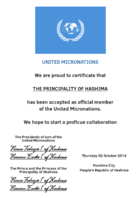
The Principality of Hashima establishes and maintains diplomatic relations with other nations through the Ministry of Foreign Affairs.
The Minister has the power to grant "states of friendship" and tacit recognition, but official recognition of another nation can only be granted by an Act of Parliament or a Royal Decree. In rare case, it can be granted also by a referendum (for example in case of disputes between two or more Nations/Micronations for the same territory or parts of it).
However, the Minister of Foreign Affairs of Hashima has the power to ratify treaties of mutual recognition and diplomatic affairs, only after had received the authorization from the Prince and the Princess with a Royal Decree.
The Principality of Hashima has, since its independence, diplomatic relations mainly through the MicroWiki Community, but also holds friendly relations with other nations founded around the web.
The Principality of Hashima keeps mutual recognition and diplomatic relations with 29 Micronations and opened 50 foreign embassies (updated to November 2015).
The Prince Fabrizio I of Hashima and the Princess Enikő I of Hashima, being also the leaders of the Nationalist Party of Hashima, have the power to grant honorary citizenships and honorary titles to other heads of State and/or other notable persons.
The Principality of Hashima is also the founding member of the United Micronations, and co-founding member (together with the Decracy of Vilthia) of the Saint Matthew Economic Pact.
The only one case of Sovereignty dispute is about the island itself, disputed between the Principality of Hashima and the Japan.
Classifications
Here there are the classifications for the Principality of Hashima, updated to November 2015:
- Billbrough-Miles: Level 3
- Boodlesmythe: Statehood
- Boodlesmythe-Tallini: Bricks and Mortar, Sizeable, Statehood — 5th World
- Dan's System: 4th World
- David's Micronational Potential Index: 4.6
- Dresner's System: 4.8
- Economic Potential Index: 4
- Linden's Revised System of Classification: 4.4
- Matthew's Democracy System of classification: 3.75
- Freayth's System of Micronational Classification: 25
- Stùrd's Liberal System of Micronational Classification: 3.9
- Tallini: 5th World
- The Milic definition of statehood: Community
- Usian Bureaucratic Scale: 3.0
Curiosities
- The Principality of Hashima doesn't have a cemetery (or however tombs), because its little area;
- Cigarettes and drugs are forbidden inside the national territory; if someone is caught in its possession risks a penalty of 1 month of home detention;
- Every building, that will be built or renovated in the national territory, is required to have a solar system energy;
- Every citizen receives from the government a subsidy of 1000 Lirint every month (a max of 1000 Lirint per person);
- The Prince of the Principality of Hashima personally contributed at the redevelopment project of the national territory;
- In case of war, all the citizens can be enlisted into the Army or another national corps;
- The Principality of Hashima, because its little surface, can't host several buildings for embassies. The government projected a multi-levels building, with a total of 200 rooms. Every foreign Country, that wants to set a diplomatic embassy in the Principality of Hashima, will be able to take possession of one room. However, rooms and building will remain property of the Principality of Hashima, that gives in free rent to the foreign Countries. It isn't expected to be built in a near future, as how for the whole project of redevelopment;
References

